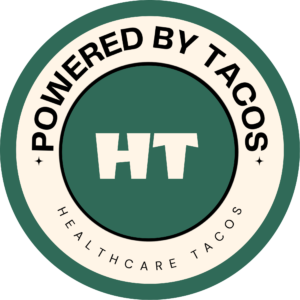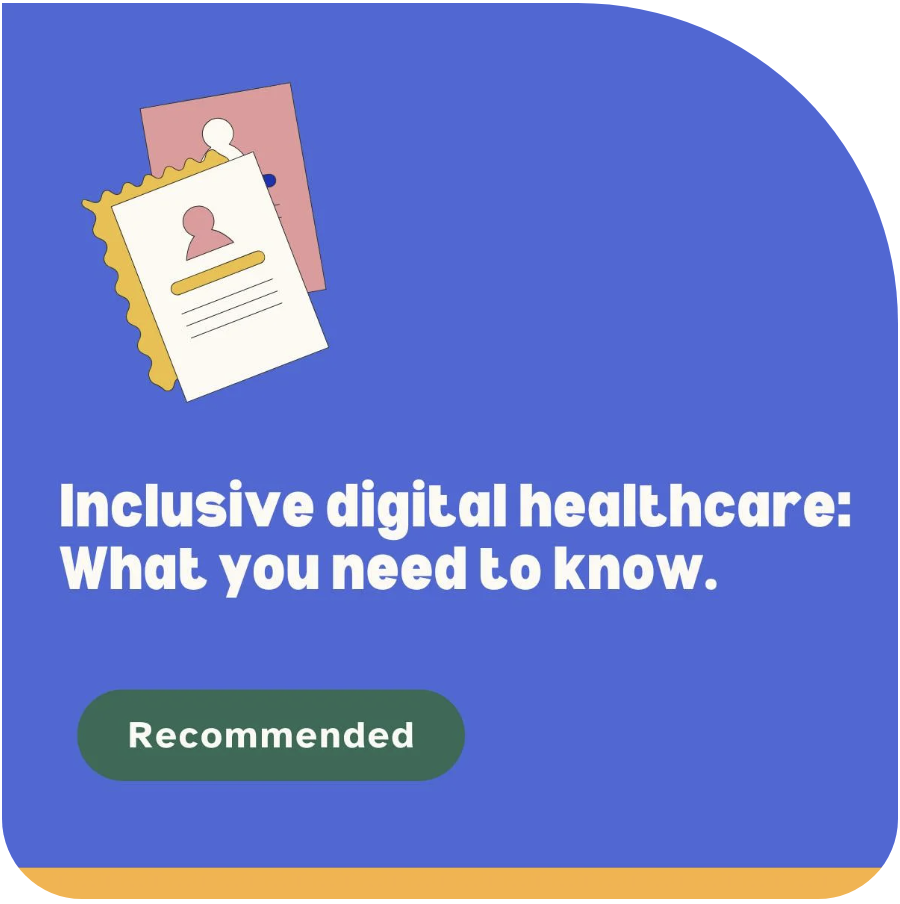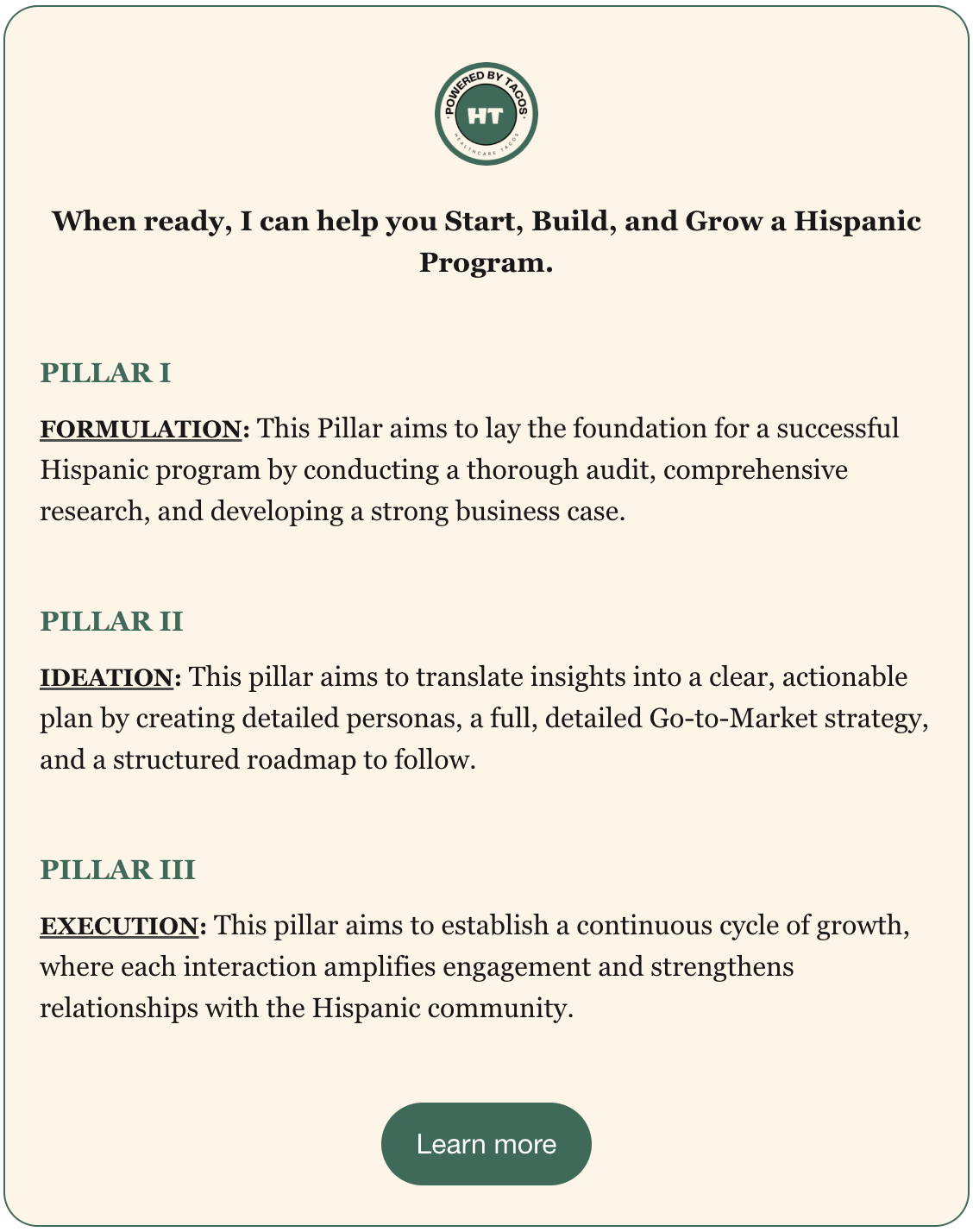

Amig@s – let’s talk about digital health inclusion.
A while back, I launched a Telehealth marketplace called “Unividoc” with a simple goal.
Connect Hispanics with doctors who speak their culture.
Sounds easy, right? Well, here is the catch.
What I didn’t expect was the massive gap in my community with people who couldn’t even access a basic Telehealth call.
In one of our early initiatives.
We held a Telehealth info session at a local community center. I remember we called it “Coffeecito” (Spanglish for “Cafecito”).
Halfway through.
Several attendees raised their hands and said.
I don’t even have a computer or internet at home. How do I join these calls with the Doctor?
That was a wake-up call.
It felt like cooking all the ingredients for a delicious Arroz con Pollo, only to realize I forgot the pollo.
Without it, it’s plain “arroz”.
That moment pushed me to think beyond flashy tech solutions and focus on bridging the basics.
- Internet access
- Digital literacy
- Local support
You know, the core ingredients for something known as “SDOH.”
Even though.
this happened a while ago; we’re still facing these same issues today.
That is why I want to share what we’ve learned and why it’s time to serve the whole enchilada in healthcare.
Making sure every patient gets a seat at the table.
Let’s taco ‘bout this today.
Amig@s – let’s talk about digital health inclusion.
A while back, I launched a Telehealth marketplace called “Unividoc” with a simple goal.
Connect Hispanics with doctors who speak their culture.
Sounds easy, right? Well, here is the catch.
What I didn’t expect was the massive gap in my community with people who couldn’t even access a basic Telehealth call.
In one of our early initiatives.
We held a Telehealth info session at a local community center. I remember we called it “Coffeecito” (Spanglish for “Cafecito”).
Halfway through.
Several attendees raised their hands and said.
I don’t even have a computer or internet at home. How do I join these calls with the Doctor?
That was a wake-up call.
It felt like cooking all the ingredients for a delicious Arroz con Pollo, only to realize I forgot the pollo.
Without it, it’s plain “arroz”.
That moment pushed me to think beyond flashy tech solutions and focus on bridging the basics.
- Internet access
- Digital literacy
- Local support
You know, the core ingredients for something known as “SDOH.”
Even though.
this happened a while ago; we’re still facing these same issues today.
That is why I want to share what we’ve learned and why it’s time to serve the whole enchilada in healthcare.
Making sure every patient gets a seat at the table.
Let’s taco ‘bout this today.
![]()
Three Insights 🌶️
I. Digital Access is a Necessity
Digital health is NOT just about convenience.
It’s a fundamental need for achieving fair healthcare.
Imagine this for a minute.
Offering Telehealth services without ensuring access. It’s like seasoning a piece of carne asada without the right mix of spices.
Sure, you have the main dish,
Yet, it’s missing the core flavors that bring it to life.
Makes sense, right?
For millions of people.
Digital access is the gateway to essential services like.
- Remote consultations
- Digital Rx prescriptions
- Health monitoring apps
Yet, a significant part of our community faces barriers, such as a lack of internet access, limited tech literacy, or a lack of devices.
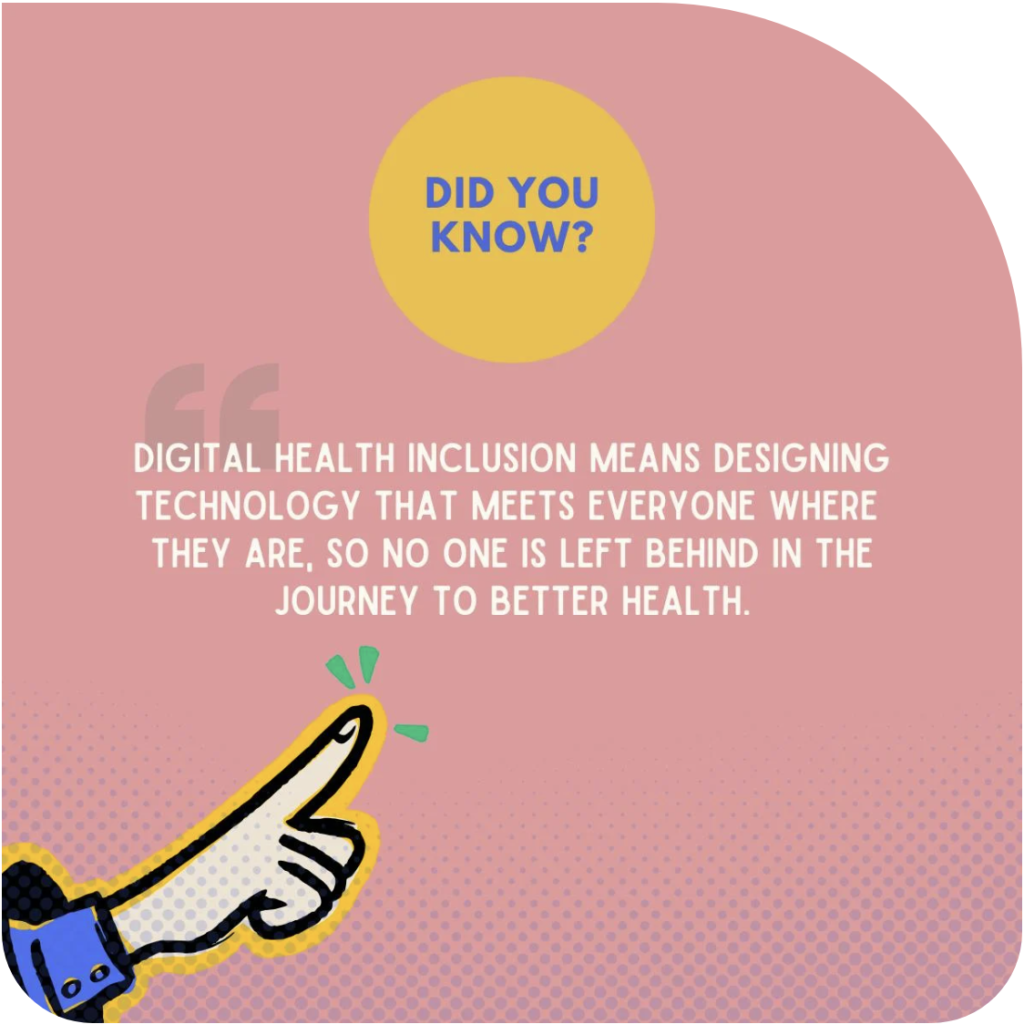
The result?
Missed check-ups, skipped appointments, and untreated health conditions.
Without basic digital skills.
Millions find it overwhelming to navigate online portals or use health-tracking apps.
It’s not just an inconvenience; it’s a matter of health equity.
When access to digital health tools is NOT prioritized, we’re shutting down millions of people from essential care.
And let’s be clear.
Without that access, we can NOT achieve true inclusivity.
So, how do we fix this?
It starts by treating digital access as a core part of healthcare, not an afterthought.
Just like you wouldn’t serve underseasoned carne asada, we can NOT offer half-baked digital solutions and call it a day.
It’s about ensuring every patient has what they need to connect, understand, and engage with their care.
II. Consistency is Key
Addressing the digital divide is NOT a one time fix; it’s a slow-cooked strategy.
Imagine making a pot of pozole or sushi, as my friend Allan did during his visit to my house in Arizona.
If you just throw in the ingredients and walk away, you won’t get the rich, comforting dish you intended.
Instead, it requires steady attention, stirring, tasting, and adjusting along the way.
The same goes for digital inclusion.
Many organizations treat digital literacy programs like a checklist item, something to do once and move on.
Yet, for those affected, a single training session is NOT enough.
The truth?
Building real digital competence takes time, repetition, and hands on support.
Consistency is key here.
If you’re ready to start making meaningful changes, here’s one practical approach to try in your work settings.
- Ongoing workshops
- Regular drop-in sessions
- Open office hours where patients can bring questions
This is about creating a supportive environment where no one is left behind.
Tools need to be intuitive, accessible, and culturally relevant.
In short.
Digital inclusion is a practical process that requires patience and persistence, qualities that lead to long-term success.
Ultimately, consistent efforts strengthen the healthcare system, reduce missed appointments, and improve patient-provider communication.
Most importantly, it fosters trust.
III. Representation Drives Innovation
You may be tired of hearing me say it, but representation truly matters.
Here’s the simple (and spicy) truth.
Diversity in healthcare leadership directly impacts digital inclusion.
Why?
When decision makers understand the communities they serve, they’re more likely to address real barriers.
Leaders who come from or closely connect with underserved communities bring essential perspectives to the table.
Perspectives that drive more effective, inclusive solutions.
Now, picture this.
We’re creating a digital health platform without considering that many users do not have reliable internet access or face language barriers that prevent them from communicating.
It’s like cooking without knowing which spices will bring out the true flavors of a dish.
You might make something edible, but it won’t resonate with those you’re trying to serve.
That’s why diverse leadership is so powerful.
Leaders who’ve experienced these gaps can advocate for essential features like multilingual support, culturally relevant resources, and offline functionalities.
Features that might otherwise be overlooked.
So here’s the deal, amig@s.
If you’re not in it for fairness, let’s make it about effectiveness.
Diverse leadership increases usability, expands reach, and strengthens market share.
Trust me.
When we prioritize representation in leadership, we ensure digital health innovations are built for everyone.
Not just for those already well served.
Inclusivity leads to better engagement, greater patient satisfaction, and increased trust in healthcare systems from all communities.
In short.
Diversity in leadership is like adding salsa roja to your dish.
It provides the necessary kick and richness, transforming the ordinary into something exceptional.
Insights
I. Digital Access is a Necessity
Digital health is NOT just about convenience.
It’s a fundamental need for achieving fair healthcare.
Imagine this for a minute.
Offering Telehealth services without ensuring access. It’s like seasoning a piece of carne asada without the right mix of spices.
Sure, you have the main dish,
Yet, it’s missing the core flavors that bring it to life.
Makes sense, right?
For millions of people.
Digital access is the gateway to essential services like.
- Remote consultations
- Digital Rx prescriptions
- Health monitoring apps
Yet, a significant part of our community faces barriers, such as a lack of internet access, limited tech literacy, or a lack of devices.

The result?
Missed check-ups, skipped appointments, and untreated health conditions.
Without basic digital skills.
Millions find it overwhelming to navigate online portals or use health-tracking apps.
It’s not just an inconvenience; it’s a matter of health equity.
When access to digital health tools is NOT prioritized, we’re shutting down millions of people from essential care.
And let’s be clear.
Without that access, we can NOT achieve true inclusivity.
So, how do we fix this?
It starts by treating digital access as a core part of healthcare, not an afterthought.
Just like you wouldn’t serve underseasoned carne asada, we can NOT offer half-baked digital solutions and call it a day.
It’s about ensuring every patient has what they need to connect, understand, and engage with their care.
II. Consistency is Key
Addressing the digital divide is NOT a one time fix; it’s a slow-cooked strategy.
Imagine making a pot of pozole or sushi, as my friend Allan did during his visit to my house in Arizona.
If you just throw in the ingredients and walk away, you won’t get the rich, comforting dish you intended.
Instead, it requires steady attention, stirring, tasting, and adjusting along the way.
The same goes for digital inclusion.
Many organizations treat digital literacy programs like a checklist item, something to do once and move on.
Yet, for those affected, a single training session is NOT enough.
The truth?
Building real digital competence takes time, repetition, and hands on support.
Consistency is key here.
If you’re ready to start making meaningful changes, here’s one practical approach to try in your work settings.
- Ongoing workshops
- Regular drop-in sessions
- Open office hours where patients can bring questions
This is about creating a supportive environment where no one is left behind.
Tools need to be intuitive, accessible, and culturally relevant.
In short.
Digital inclusion is a practical process that requires patience and persistence, qualities that lead to long-term success.
Ultimately, consistent efforts strengthen the healthcare system, reduce missed appointments, and improve patient-provider communication.
Most importantly, it fosters trust.
III. Representation Drives Innovation
You may be tired of hearing me say it, but representation truly matters.
Here’s the simple (and spicy) truth.
Diversity in healthcare leadership directly impacts digital inclusion.
Why?
When decision makers understand the communities they serve, they’re more likely to address real barriers.
Leaders who come from or closely connect with underserved communities bring essential perspectives to the table.
Perspectives that drive more effective, inclusive solutions.
Now, picture this.
We’re creating a digital health platform without considering that many users do not have reliable internet access or face language barriers that prevent them from communicating.
It’s like cooking without knowing which spices will bring out the true flavors of a dish.
You might make something edible, but it won’t resonate with those you’re trying to serve.
That’s why diverse leadership is so powerful.
Leaders who’ve experienced these gaps can advocate for essential features like multilingual support, culturally relevant resources, and offline functionalities.
Features that might otherwise be overlooked.
So here’s the deal, amig@s.
If you’re not in it for fairness, let’s make it about effectiveness.
Diverse leadership increases usability, expands reach, and strengthens market share.
Trust me.
When we prioritize representation in leadership, we ensure digital health innovations are built for everyone.
Not just for those already well served.
Inclusivity leads to better engagement, greater patient satisfaction, and increased trust in healthcare systems from all communities.
In short.
Diversity in leadership is like adding salsa roja to your dish.
It provides the necessary kick and richness, transforming the ordinary into something exceptional.
![]()
Two Actionable Steps 🌮
I. Digital Literacy Bootcamps
I love this and have done it many times throughout my career in the U.S. and LATAM.
Digital literacy bootcamps are a practical way to bridge the knowledge gap.
Most importantly.
Empower patients with the skills they need to engage confidently with digital healthcare.
Exactly my goal with Health Trip. (Find under volunteer work).

To reach vulnerable, remote areas in LATAM, offering healthcare services and teaching people how to use them.
The results were incredible.
Out of 5,000 people we were able to help, about 35% returned three times in the following 12 months and used the Unividoc platform.
That’s 1,700 people who, before our initial interaction, had no idea how to engage with digital health.
Amazing, right?
Here’s how you can create the same impact.
Start small with workshops that give patients the confidence to access your digital solutions.
If even one person shows up, that’s progress; you’re making a difference.
This one person will tell family and neighbors, and soon enough, you’ll have a room full of people eager to learn.
Trust me, that’s how it works.
Think of these bootcamps as ongoing cooking classes.
You wouldn’t hand someone a recipe and expect them to master it overnight.
Instead, do these four things.
- Walk them through each step
- Give them time to understand
- Ask questions and engage with them
- Practice alongside them
In digital health.
Patients need this kind of steady, guided approach to build real confidence and avoid feeling overwhelmed.
These sessions can include hands-on demonstrations for tasks like:
- Scheduling appointments
- Filling out digital forms
- Sharing personal health information securely
Break down each of these into bite-sized, practical lessons so participants get achievable steps rather than an overload of information.
Consider setting up “office hours”.
Where patients can drop in with questions or for tech support after bootcamps.
Remember.
Consistent, interactive sessions let patients reinforce what they’ve learned, moving from “just figuring it out” to real digital confidence.
Over time.
This consistency helps patients normalize digital health tools, turning once daunting tasks into accessible, everyday parts of their healthcare journey.
And in doing so.
You create a solid base of digitally savvy patients in your market, paving the way for trust and ongoing engagement.
II. Partner with Local Organizations
This is one of my favorite parts of making healthcare Hispanic-friendly together.
Building digital access and support is NOT something we can do alone.
Collaborating with local organizations like.
- Community centers
- Libraries
- Non-profits
It is key to truly tackling the digital divide.
These organizations play a crucial role in expanding internet access and providing ongoing support.
Think of this as filling a burrito.
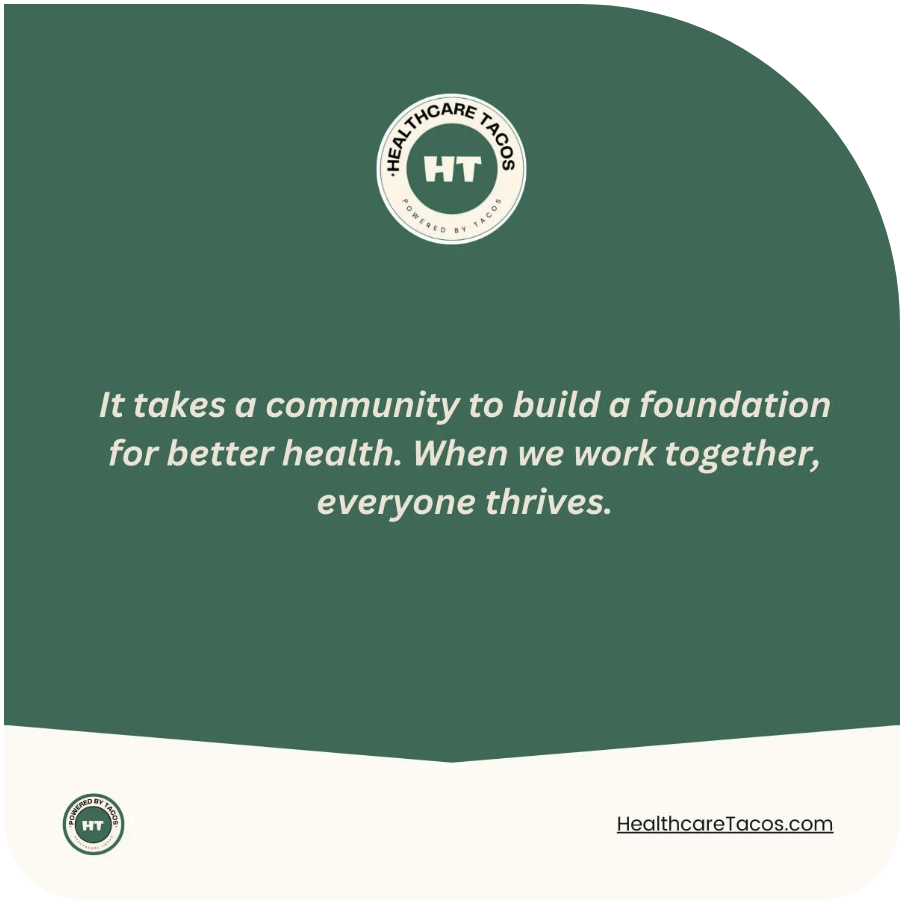
Addressing not just the surface but reinforcing the core so digital inclusion becomes truly sustainable.
For instance:
- Community centers can serve as local hubs where patients attend digital literacy sessions and access the internet for Telehealth services.
- Libraries can host tech workshops and provide computers or tablets for patients who lack devices.
- Non-profits bring valuable insights into the needs of Hispanic communities and can offer culturally relevant materials and bilingual support.
What’s the point here?
By pooling resources with local partners.
You extend your reach, addressing immediate digital access issues so patients can confidently use digital health tools.
The best part?
These partnerships build a lasting foundation for digital inclusion.
They don’t just add a temporary layer; they strengthen the entire community, helping lower social determinants of health and improving health equity in a way that lasts forever.
Actionable Steps
I. Digital Literacy Bootcamps
I love this and have done it many times throughout my career in the U.S. and LATAM.
Digital literacy bootcamps are a practical way to bridge the knowledge gap.
Most importantly.
Empower patients with the skills they need to engage confidently with digital healthcare.
Exactly my goal with Health Trip. (Find under volunteer work).

To reach vulnerable, remote areas in LATAM, offering healthcare services and teaching people how to use them.
The results were incredible.
Out of 5,000 people we were able to help, about 35% returned three times in the following 12 months and used the Unividoc platform.
That’s 1,700 people who, before our initial interaction, had no idea how to engage with digital health.
Amazing, right?
Here’s how you can create the same impact.
Start small with workshops that give patients the confidence to access your digital solutions.
If even one person shows up, that’s progress; you’re making a difference.
This one person will tell family and neighbors, and soon enough, you’ll have a room full of people eager to learn.
Trust me, that’s how it works.
Think of these bootcamps as ongoing cooking classes.
You wouldn’t hand someone a recipe and expect them to master it overnight.
Instead, do these four things.
- Walk them through each step
- Give them time to understand
- Ask questions and engage with them
- Practice alongside them
In digital health.
Patients need this kind of steady, guided approach to build real confidence and avoid feeling overwhelmed.
These sessions can include hands-on demonstrations for tasks like:
- Scheduling appointments
- Filling out digital forms
- Sharing personal health information securely
Break down each of these into bite-sized, practical lessons so participants get achievable steps rather than an overload of information.
Consider setting up “office hours”.
Where patients can drop in with questions or for tech support after bootcamps.
Remember.
Consistent, interactive sessions let patients reinforce what they’ve learned, moving from “just figuring it out” to real digital confidence.
Over time.
This consistency helps patients normalize digital health tools, turning once daunting tasks into accessible, everyday parts of their healthcare journey.
And in doing so.
You create a solid base of digitally savvy patients in your market, paving the way for trust and ongoing engagement.
II. Partner with Local Orgs
This is one of my favorite parts of making healthcare Hispanic-friendly together.
Building digital access and support is NOT something we can do alone.
Collaborating with local organizations like.
- Community centers
- Libraries
- Non-profits
It is key to truly tackling the digital divide.
These organizations play a crucial role in expanding internet access and providing ongoing support.
Think of this as filling a burrito.

Addressing not just the surface but reinforcing the core so digital inclusion becomes truly sustainable.
For instance:
- Community centers can serve as local hubs where patients attend digital literacy sessions and access the internet for Telehealth services.
- Libraries can host tech workshops and provide computers or tablets for patients who lack devices.
- Non-profits bring valuable insights into the needs of Hispanic communities and can offer culturally relevant materials and bilingual support.
What’s the point here?
By pooling resources with local partners.
You extend your reach, addressing immediate digital access issues so patients can confidently use digital health tools.
The best part?
These partnerships build a lasting foundation for digital inclusion.
They don’t just add a temporary layer; they strengthen the entire community, helping lower social determinants of health and improving health equity in a way that lasts forever.
![]()
One Piece of Advice 💃
Addressing the digital divide among Hispanics is more of an art than a sprint.
Think of it like preparing a rich pozole or a perfectly balanced margarita.
It requires.
- Patience
- Ongoing effort
- Willingness to adapt
You can’t rush the process or toss in a few ingredients and expect perfection.
Digital inclusion is about letting the ingredients blend over time to build a solid foundation.
So keep simmering, stirring, and tasting.
Each step in your strategy may need small tweaks along the way.
Patients might need extra support with Telehealth basics, or there may be a growing need for bilingual resources.
Every time, you “taste” your progress through feedback, outcomes, and patient experiences.
You get an opportunity to add just the right “seasoning” to make digital health more accessible and meaningful.
And when that happens, my community will be forever grateful.
Piece of Advice
Addressing the digital divide among Hispanics is more of an art than a sprint.
Think of it like preparing a rich pozole or a perfectly balanced margarita.
It requires.
- Patience
- Ongoing effort
- Willingness to adapt
You can’t rush the process or toss in a few ingredients and expect perfection.
Digital inclusion is about letting the ingredients blend over time to build a solid foundation.
So keep simmering, stirring, and tasting.
Each step in your strategy may need small tweaks along the way.
Patients might need extra support with Telehealth basics, or there may be a growing need for bilingual resources.
Every time, you “taste” your progress through feedback, outcomes, and patient experiences.
You get an opportunity to add just the right “seasoning” to make digital health more accessible and meaningful.
And when that happens, my community will be forever grateful.
![]()
